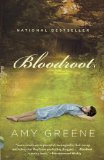Summary | Excerpt | Reading Guide | Reviews | Beyond the Book | Read-Alikes | Genres & Themes | Author Bio

This article relates to Bloodroot
 Characters in Bloodroot rely on William
Wordsworth's poetry as a source of comfort and inspiration, but echoes of
his literary philosophy and poetic interests can also be found in the
pages of Amy Greene's novel.
Characters in Bloodroot rely on William
Wordsworth's poetry as a source of comfort and inspiration, but echoes of
his literary philosophy and poetic interests can also be found in the
pages of Amy Greene's novel.
Just as Bloodroot relies on memory to tell its stories, much of Wordsworth's poetry focuses on capturing moments of memory and recollection. He developed a philosophy of "two consciousnesses": himself in the present and himself in the past, and a lot of his poetry sought to identify the discrepancy between these two. Whereas Marcel Proust, in his exhausting account, In Search of Lost Time, pursues the depth of memory through the taste of his madeleine cookie, Wordsworth's poetry explores the disjuncture between what is now and what was then.
Memory aside, Wordsworth is most famous for his depiction of daffodils in "I
Wandered as Lonely as a Cloud." Throughout the poem, the speaker revels in
the beauty of a field of daffodils, only to have the scene shattered when it becomes
clear that the daffodils only exist in his memory. The daffodils that
Wordsworth describes are carefully personified, described as "golden" and "dancing"
which grants the flowers authority. The power of Wordsworth's daffodils and natural
world is similar to the role that the bloodroot plant plays in Amy Greene's inaugural
novel.
Filed under Books and Authors
![]() This "beyond the book article" relates to Bloodroot. It originally ran in February 2010 and has been updated for the
January 2011 paperback edition.
Go to magazine.
This "beyond the book article" relates to Bloodroot. It originally ran in February 2010 and has been updated for the
January 2011 paperback edition.
Go to magazine.
Your guide toexceptional books
BookBrowse seeks out and recommends the best in contemporary fiction and nonfiction—books that not only engage and entertain but also deepen our understanding of ourselves and the world around us.